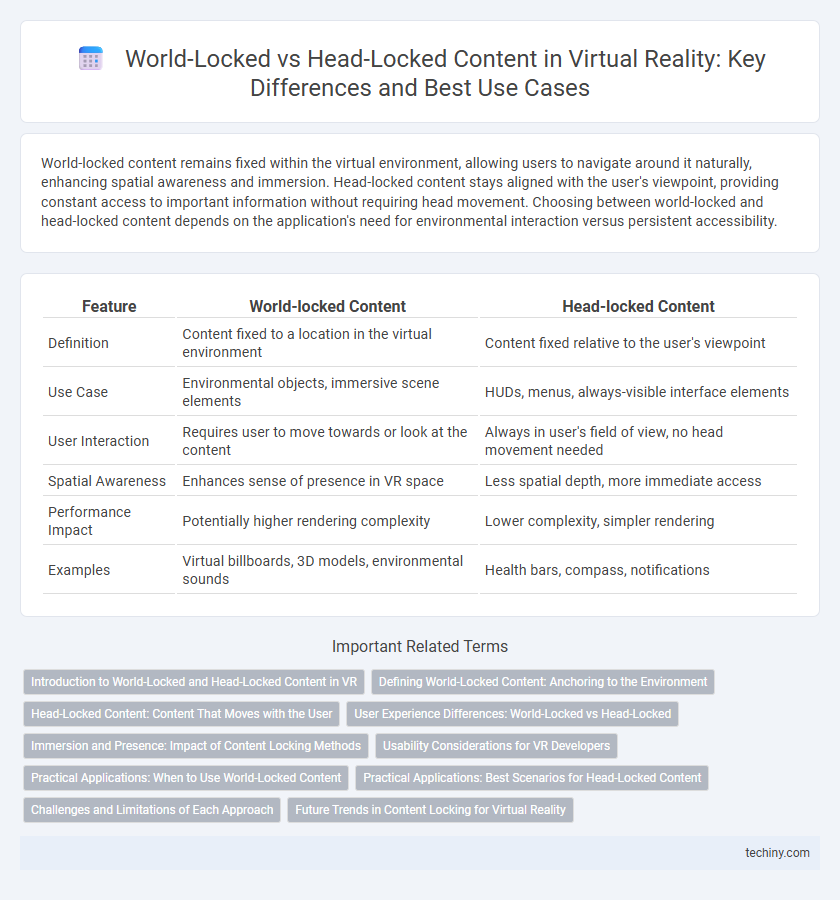World-locked content remains fixed within the virtual environment, allowing users to navigate around it naturally, enhancing spatial awareness and immersion. Head-locked content stays aligned with the user's viewpoint, providing constant access to important information without requiring head movement. Choosing between world-locked and head-locked content depends on the application's need for environmental interaction versus persistent accessibility.
Table of Comparison
| Feature | World-locked Content | Head-locked Content |
|---|---|---|
| Definition | Content fixed to a location in the virtual environment | Content fixed relative to the user's viewpoint |
| Use Case | Environmental objects, immersive scene elements | HUDs, menus, always-visible interface elements |
| User Interaction | Requires user to move towards or look at the content | Always in user's field of view, no head movement needed |
| Spatial Awareness | Enhances sense of presence in VR space | Less spatial depth, more immediate access |
| Performance Impact | Potentially higher rendering complexity | Lower complexity, simpler rendering |
| Examples | Virtual billboards, 3D models, environmental sounds | Health bars, compass, notifications |
Introduction to World-Locked and Head-Locked Content in VR
World-locked content in virtual reality remains fixed in a specific position within the virtual environment, allowing users to explore and interact with it as they move around. Head-locked content, in contrast, stays fixed relative to the user's viewpoint, moving in sync with head movements to provide consistent information or interface elements. Understanding the differences between world-locked and head-locked content is essential for designing immersive VR experiences that balance spatial awareness and user accessibility.
Defining World-Locked Content: Anchoring to the Environment
World-locked content in virtual reality remains fixed relative to the physical environment, anchoring objects consistently in real-world coordinates regardless of the user's head movement. This spatial stability allows for immersive experiences where virtual elements appear integrated within the actual surroundings, enhancing realism and user orientation. By contrast, world-locked content maintains a persistent position in the environment, enabling reliable interaction and natural navigation within mixed reality applications.
Head-Locked Content: Content That Moves with the User
Head-locked content in virtual reality maintains a fixed position relative to the user's viewpoint, creating an immersive experience by moving synchronously with head movements. This enables consistent visibility and interaction with crucial UI elements, such as menus, HUDs, and notifications, regardless of the user's orientation. Head-locked content enhances usability by reducing the need for users to reposition themselves to access important information.
User Experience Differences: World-Locked vs Head-Locked
World-locked content maintains a fixed position in the virtual environment, enhancing spatial awareness and immersion by allowing users to explore around stable elements. Head-locked content, tethered to the user's viewpoint, ensures constant visibility and ease of interaction, but may reduce the sense of depth and environmental context. User experience varies as world-locked objects foster natural exploration, while head-locked elements provide consistent accessibility without disrupting focus.
Immersion and Presence: Impact of Content Locking Methods
World-locked content anchors virtual objects to specific real-world locations, enhancing spatial awareness and reinforcing a sense of place, which significantly boosts immersion and presence. Head-locked content maintains virtual elements fixed relative to the user's head movement, providing constant visual access but potentially reducing the feeling of being anchored in a shared environment. Immersion and presence are maximized by balancing these locking methods, leveraging world-locked content to ground users while using head-locked content for persistent interface elements.
Usability Considerations for VR Developers
World-locked content remains fixed in the virtual environment, enhancing spatial awareness and encouraging natural navigation, which improves user comfort during prolonged VR sessions. Head-locked content moves with the user's gaze, providing instant access to essential information but risking cognitive overload and motion sickness if overused. Developers must balance these approaches by strategically placing world-locked elements for immersive interactions while limiting head-locked overlays to minimize distraction and maintain user focus.
Practical Applications: When to Use World-Locked Content
World-locked content in virtual reality provides a stable, fixed position within the virtual environment, making it ideal for applications such as architectural visualization, training simulations, and collaborative workspaces where spatial consistency enhances user understanding. This approach ensures that virtual objects remain anchored to a specific location, allowing users to explore and interact with them naturally as they move through the space. Practical use of world-locked content is crucial in scenarios requiring precise spatial awareness and realistic interaction with the virtual surroundings.
Practical Applications: Best Scenarios for Head-Locked Content
Head-locked content is ideal for user interfaces and HUD elements in virtual reality, ensuring essential information remains fixed in the user's field of view regardless of head movement. It enhances user immersion in gaming by providing constant access to health stats, maps, or notifications without breaking spatial consistency. Practical applications also include training simulations where critical instructions or tooltips need to stay visible to guide the user continuously.
Challenges and Limitations of Each Approach
World-locked content in virtual reality faces challenges such as maintaining spatial accuracy and stability across different user perspectives, which can result in misalignment or motion sickness if tracking is imprecise. Head-locked content, while ensuring consistent visibility and user focus, suffers from limitations including reduced immersion and potential annoyance due to its constant presence within the user's field of view. Balancing these approaches requires addressing tracking fidelity for world-locked objects and designing unobtrusive, context-aware interfaces for head-locked elements.
Future Trends in Content Locking for Virtual Reality
Future trends in Virtual Reality content locking emphasize advanced world-locked experiences that seamlessly integrate digital objects within physical environments, enhancing spatial awareness and user immersion. Emerging technologies like inside-out tracking and AI-driven spatial mapping improve the stability and relevance of world-locked content, enabling dynamic interaction with real-world elements. Head-locked content will evolve to prioritize personalized interfaces and HUDs, while hybrid approaches combine both methods to optimize user engagement and accessibility in diverse VR applications.
World-locked Content vs Head-locked Content Infographic

 techiny.com
techiny.com